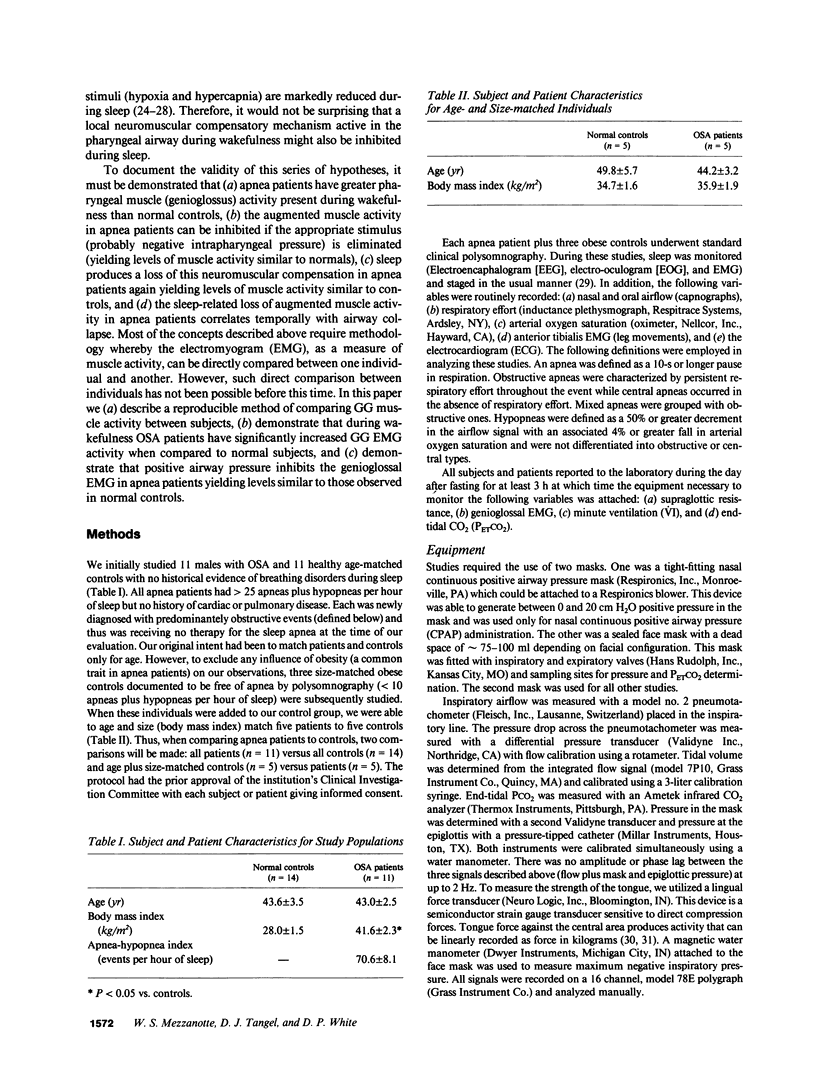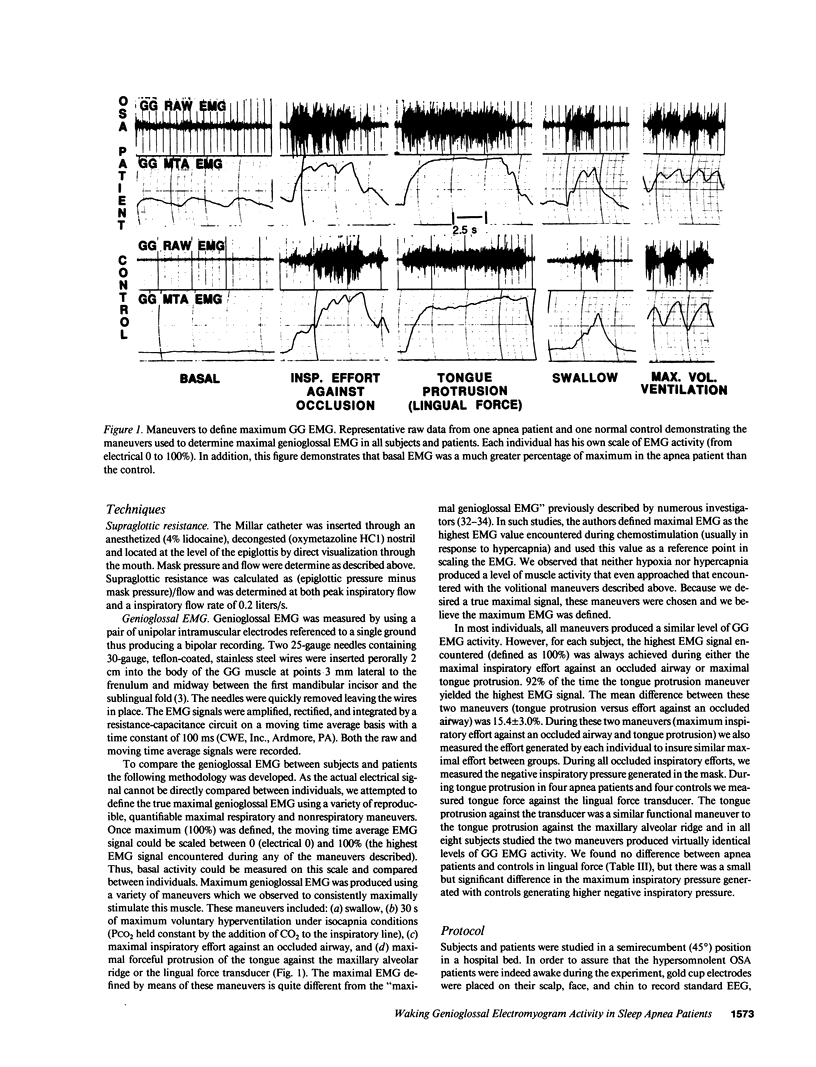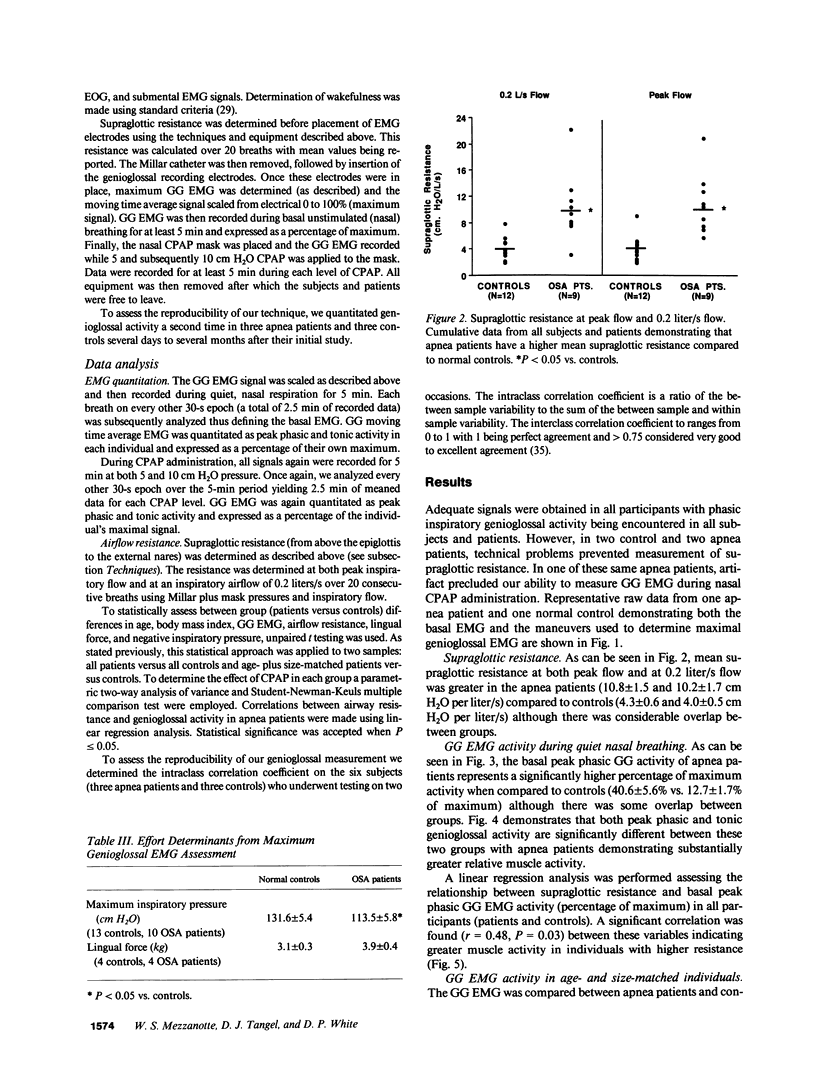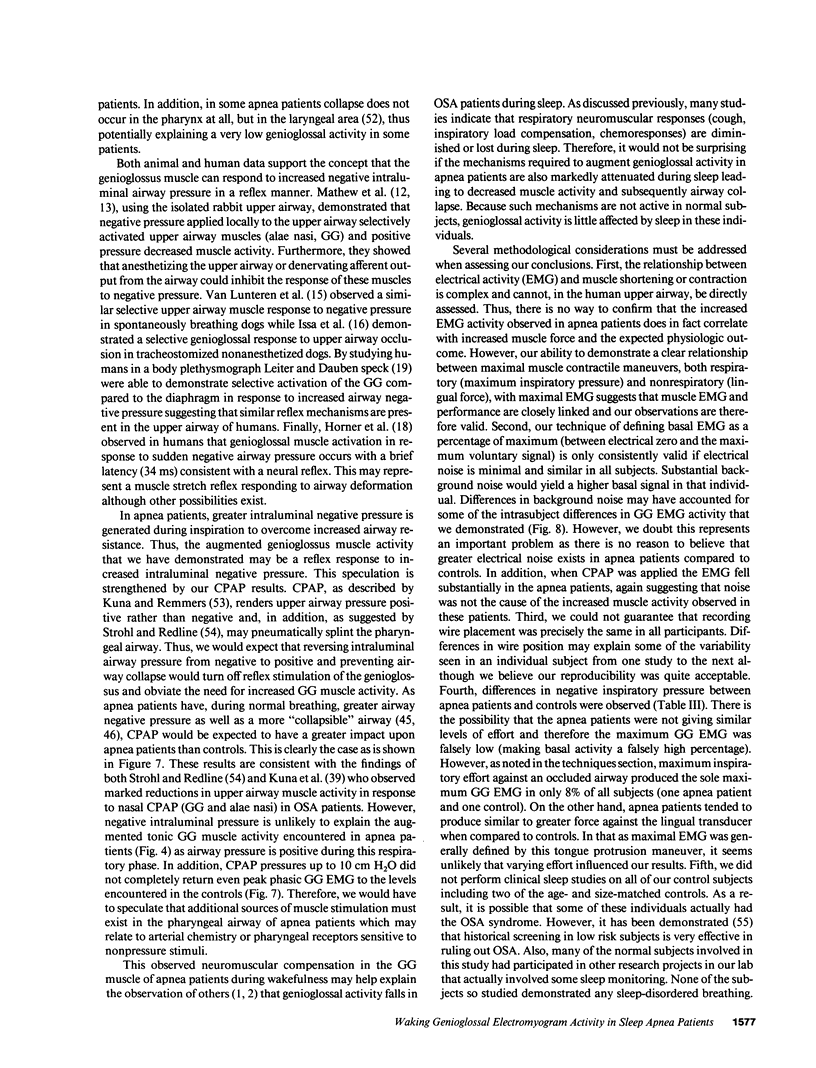Abstract
Pharyngeal collapse in obstructive sleep apnea patients is likely a product of a sleep-related decrement in pharyngeal dilator muscle activity superimposed upon abnormal airway anatomy. We postulate that during wakefulness, increased pharyngeal dilator muscle activity in apnea patients compensates for diminished airway size thus maintaining patency. We studied the waking genioglossus (GG) electromyogram (EMG) activity in 11 OSA patients and 14 age-matched controls to determine if GG activity is higher in the awake state in apnea patients than controls. To make this determination, we developed a reproducible methodology whereby true maximal GG EMG could be defined and thus basal activity quantitated as a percentage of this maximal value. Therefore, direct comparisons of basal activity between individuals was possible. We observed apnea patients to have significantly greater basal genioglossal activity compared to controls (40.6 +/- 5.6% vs. 12.7 +/- 1.7% of maximum). This difference persisted when size-matched subsets were compared. This augmented GG activity in apnea patients could be reduced with positive airway pressure. We speculate that this neuromuscular compensation present during wakefulness in apnea patients may be lost during sleep leading to airway collapse.
Full text
PDF








Selected References
These references are in PubMed. This may not be the complete list of references from this article.
- Alex C. G., Aronson R. M., Onal E., Lopata M. Effects of continuous positive airway pressure on upper airway and respiratory muscle activity. J Appl Physiol (1985) 1987 May;62(5):2026–2030. doi: 10.1152/jappl.1987.62.5.2026. [DOI] [PubMed] [Google Scholar]
- Anch A. M., Remmers J. E., Bunce H., 3rd Supraglottic airway resistance in normal subjects and patients with occlusive sleep apnea. J Appl Physiol Respir Environ Exerc Physiol. 1982 Nov;53(5):1158–1163. doi: 10.1152/jappl.1982.53.5.1158. [DOI] [PubMed] [Google Scholar]
- Barlow S. M., Abbs J. H. Force transducers for the evaluation of labial, lingual, and mandibular motor impairments. J Speech Hear Res. 1983 Dec;26(4):616–621. doi: 10.1044/jshr.2604.616. [DOI] [PubMed] [Google Scholar]
- Basner R. C., Simon P. M., Schwartzstein R. M., Weinberger S. E., Weiss J. W. Breathing route influences upper airway muscle activity in awake normal adults. J Appl Physiol (1985) 1989 Apr;66(4):1766–1771. doi: 10.1152/jappl.1989.66.4.1766. [DOI] [PubMed] [Google Scholar]
- Berthon-Jones M., Sullivan C. E. Ventilation and arousal responses to hypercapnia in normal sleeping humans. J Appl Physiol Respir Environ Exerc Physiol. 1984 Jul;57(1):59–67. doi: 10.1152/jappl.1984.57.1.59. [DOI] [PubMed] [Google Scholar]
- Berthon-Jones M., Sullivan C. E. Ventilatory and arousal responses to hypoxia in sleeping humans. Am Rev Respir Dis. 1982 Jun;125(6):632–639. doi: 10.1164/arrd.1982.125.6.632. [DOI] [PubMed] [Google Scholar]
- Bradley T. D., Brown I. G., Grossman R. F., Zamel N., Martinez D., Phillipson E. A., Hoffstein V. Pharyngeal size in snorers, nonsnorers, and patients with obstructive sleep apnea. N Engl J Med. 1986 Nov 20;315(21):1327–1331. doi: 10.1056/NEJM198611203152105. [DOI] [PubMed] [Google Scholar]
- Brown I. G., Bradley T. D., Phillipson E. A., Zamel N., Hoffstein V. Pharyngeal compliance in snoring subjects with and without obstructive sleep apnea. Am Rev Respir Dis. 1985 Aug;132(2):211–215. doi: 10.1164/arrd.1985.132.2.211. [DOI] [PubMed] [Google Scholar]
- Douglas N. J., White D. P., Weil J. V., Pickett C. K., Martin R. J., Hudgel D. W., Zwillich C. W. Hypoxic ventilatory response decreases during sleep in normal men. Am Rev Respir Dis. 1982 Mar;125(3):286–289. doi: 10.1164/arrd.1982.125.3.286. [DOI] [PubMed] [Google Scholar]
- Douglas N. J., White D. P., Weil J. V., Pickett C. K., Zwillich C. W. Hypercapnic ventilatory response in sleeping adults. Am Rev Respir Dis. 1982 Nov;126(5):758–762. doi: 10.1164/arrd.1982.126.5.758. [DOI] [PubMed] [Google Scholar]
- Dworkin J. P., Aronson A. E., Mulder D. W. Tongue force in normals and in dysarthric patients with amyotrophic lateral sclerosis. J Speech Hear Res. 1980 Dec;23(4):828–837. doi: 10.1044/jshr.2304.828. [DOI] [PubMed] [Google Scholar]
- Haponik E. F., Smith P. L., Bohlman M. E., Allen R. P., Goldman S. M., Bleecker E. R. Computerized tomography in obstructive sleep apnea. Correlation of airway size with physiology during sleep and wakefulness. Am Rev Respir Dis. 1983 Feb;127(2):221–226. doi: 10.1164/arrd.1983.127.2.221. [DOI] [PubMed] [Google Scholar]
- Horner R. L., Innes J. A., Murphy K., Guz A. Evidence for reflex upper airway dilator muscle activation by sudden negative airway pressure in man. J Physiol. 1991 May;436:15–29. doi: 10.1113/jphysiol.1991.sp018536. [DOI] [PMC free article] [PubMed] [Google Scholar]
- Hudgel D. W., Mulholland M., Hendricks C. Neuromuscular and mechanical responses to inspiratory resistive loading during sleep. J Appl Physiol (1985) 1987 Aug;63(2):603–608. doi: 10.1152/jappl.1987.63.2.603. [DOI] [PubMed] [Google Scholar]
- Hudgel D. W. Variable site of airway narrowing among obstructive sleep apnea patients. J Appl Physiol (1985) 1986 Oct;61(4):1403–1409. doi: 10.1152/jappl.1986.61.4.1403. [DOI] [PubMed] [Google Scholar]
- Iber C., Berssenbrugge A., Skatrud J. B., Dempsey J. A. Ventilatory adaptations to resistive loading during wakefulness and non-REM sleep. J Appl Physiol Respir Environ Exerc Physiol. 1982 Mar;52(3):607–614. doi: 10.1152/jappl.1982.52.3.607. [DOI] [PubMed] [Google Scholar]
- Issa F. G., Edwards P., Szeto E., Lauff D., Sullivan C. Genioglossus and breathing responses to airway occlusion: effect of sleep and route of occlusion. J Appl Physiol (1985) 1988 Feb;64(2):543–549. doi: 10.1152/jappl.1988.64.2.543. [DOI] [PubMed] [Google Scholar]
- Jeffries B., Brouillette R. T., Hunt C. E. Electromyographic study of some accessory muscles of respiration in children with obstructive sleep apnea. Am Rev Respir Dis. 1984 May;129(5):696–702. doi: 10.1164/arrd.1984.129.5.696. [DOI] [PubMed] [Google Scholar]
- Krol R. C., Knuth S. L., Bartlett D., Jr Selective reduction of genioglossal muscle activity by alcohol in normal human subjects. Am Rev Respir Dis. 1984 Feb;129(2):247–250. [PubMed] [Google Scholar]
- Kuna S. T., Bedi D. G., Ryckman C. Effect of nasal airway positive pressure on upper airway size and configuration. Am Rev Respir Dis. 1988 Oct;138(4):969–975. doi: 10.1164/ajrccm/138.4.969. [DOI] [PubMed] [Google Scholar]
- Kuna S. T., Remmers J. E. Neural and anatomic factors related to upper airway occlusion during sleep. Med Clin North Am. 1985 Nov;69(6):1221–1242. doi: 10.1016/s0025-7125(16)30984-1. [DOI] [PubMed] [Google Scholar]
- Kuna S. T., Smickley J. Response of genioglossus muscle activity to nasal airway occlusion in normal sleeping adults. J Appl Physiol (1985) 1988 Jan;64(1):347–353. doi: 10.1152/jappl.1988.64.1.347. [DOI] [PubMed] [Google Scholar]
- Leiter J. C., Daubenspeck J. A. Selective reflex activation of the genioglossus in humans. J Appl Physiol (1985) 1990 Jun;68(6):2581–2587. doi: 10.1152/jappl.1990.68.6.2581. [DOI] [PubMed] [Google Scholar]
- Leiter J. C., Knuth S. L., Bartlett D., Jr The effect of sleep deprivation on activity of the genioglossus muscle. Am Rev Respir Dis. 1985 Dec;132(6):1242–1245. doi: 10.1164/arrd.1985.132.6.1242. [DOI] [PubMed] [Google Scholar]
- Mathew O. P., Abu-Osba Y. K., Thach B. T. Genioglossus muscle responses to upper airway pressure changes: afferent pathways. J Appl Physiol Respir Environ Exerc Physiol. 1982 Feb;52(2):445–450. doi: 10.1152/jappl.1982.52.2.445. [DOI] [PubMed] [Google Scholar]
- Mathew O. P., Abu-Osba Y. K., Thach B. T. Influence of upper airway pressure changes on genioglossus muscle respiratory activity. J Appl Physiol Respir Environ Exerc Physiol. 1982 Feb;52(2):438–444. doi: 10.1152/jappl.1982.52.2.438. [DOI] [PubMed] [Google Scholar]
- Onal E., Lopata M., O'Connor T. D. Diaphragmatic and genioglossal electromyogram responses to CO2 rebreathing in humans. J Appl Physiol Respir Environ Exerc Physiol. 1981 May;50(5):1052–1055. doi: 10.1152/jappl.1981.50.5.1052. [DOI] [PubMed] [Google Scholar]
- Onal E., Lopata M., O'Connor T. Pathogenesis of apneas in hypersomnia-sleep apnea syndrome. Am Rev Respir Dis. 1982 Feb;125(2):167–174. doi: 10.1164/arrd.1982.125.2.167. [DOI] [PubMed] [Google Scholar]
- Patrick G. B., Strohl K. P., Rubin S. B., Altose M. D. Upper airway and diaphragm muscle responses to chemical stimulation and loading. J Appl Physiol Respir Environ Exerc Physiol. 1982 Nov;53(5):1133–1137. doi: 10.1152/jappl.1982.53.5.1133. [DOI] [PubMed] [Google Scholar]
- Power J. T., Stewart I. C., Connaughton J. J., Brash H. M., Shapiro C. M., Flenley D. C., Douglas N. J. Nocturnal cough in patients with chronic bronchitis and emphysema. Am Rev Respir Dis. 1984 Dec;130(6):999–1001. doi: 10.1164/arrd.1984.130.6.999. [DOI] [PubMed] [Google Scholar]
- Redline S., Strohl K. P. Influence of upper airway sensory receptors on respiratory muscle activation in humans. J Appl Physiol (1985) 1987 Jul;63(1):368–374. doi: 10.1152/jappl.1987.63.1.368. [DOI] [PubMed] [Google Scholar]
- Remmers J. E., deGroot W. J., Sauerland E. K., Anch A. M. Pathogenesis of upper airway occlusion during sleep. J Appl Physiol Respir Environ Exerc Physiol. 1978 Jun;44(6):931–938. doi: 10.1152/jappl.1978.44.6.931. [DOI] [PubMed] [Google Scholar]
- Rivlin J., Hoffstein V., Kalbfleisch J., McNicholas W., Zamel N., Bryan A. C. Upper airway morphology in patients with idiopathic obstructive sleep apnea. Am Rev Respir Dis. 1984 Mar;129(3):355–360. doi: 10.1164/arrd.1984.129.3.355. [DOI] [PubMed] [Google Scholar]
- Rodenstein D. O., Stănescu D. C. The soft palate and breathing. Am Rev Respir Dis. 1986 Aug;134(2):311–325. doi: 10.1164/arrd.1986.134.2.311. [DOI] [PubMed] [Google Scholar]
- Rubinstein I., Slutsky A. S., Zamel N., Hoffstein V. Paradoxical glottic narrowing in patients with severe obstructive sleep apnea. J Clin Invest. 1988 Apr;81(4):1051–1055. doi: 10.1172/JCI113416. [DOI] [PMC free article] [PubMed] [Google Scholar]
- Sauerland E. K., Harper R. M. The human tongue during sleep: electromyographic activity of the genioglossus muscle. Exp Neurol. 1976 Apr;51(1):160–170. doi: 10.1016/0014-4886(76)90061-3. [DOI] [PubMed] [Google Scholar]
- Sauerland E. K., Orr W. C., Hairston L. E. DMG patterns of oropharyngeal muscles during respiration in wakefulness and sleep. Electromyogr Clin Neurophysiol. 1981 Feb-Mar;21(2-3):307–316. [PubMed] [Google Scholar]
- Shepard J. W., Jr, Thawley S. E. Localization of upper airway collapse during sleep in patients with obstructive sleep apnea. Am Rev Respir Dis. 1990 May;141(5 Pt 1):1350–1355. doi: 10.1164/ajrccm/141.5_Pt_1.1350. [DOI] [PubMed] [Google Scholar]
- Stauffer J. L., Zwillich C. W., Cadieux R. J., Bixler E. O., Kales A., Varano L. A., White D. P. Pharyngeal size and resistance in obstructive sleep apnea. Am Rev Respir Dis. 1987 Sep;136(3):623–627. doi: 10.1164/ajrccm/136.3.623. [DOI] [PubMed] [Google Scholar]
- Strohl K. P., Olson L. G. Concerning the importance of pharyngeal muscles in the maintenance of upper airway patency during sleep. An opinion. Chest. 1987 Nov;92(5):918–920. doi: 10.1378/chest.92.5.918. [DOI] [PubMed] [Google Scholar]
- Strohl K. P., Redline S. Nasal CPAP therapy, upper airway muscle activation, and obstructive sleep apnea. Am Rev Respir Dis. 1986 Sep;134(3):555–558. doi: 10.1164/arrd.1986.134.3.555. [DOI] [PubMed] [Google Scholar]
- Suratt P. M., Dee P., Atkinson R. L., Armstrong P., Wilhoit S. C. Fluoroscopic and computed tomographic features of the pharyngeal airway in obstructive sleep apnea. Am Rev Respir Dis. 1983 Apr;127(4):487–492. doi: 10.1164/arrd.1983.127.4.487. [DOI] [PubMed] [Google Scholar]
- Suratt P. M., McTier R. F., Wilhoit S. C. Collapsibility of the nasopharyngeal airway in obstructive sleep apnea. Am Rev Respir Dis. 1985 Nov;132(5):967–971. doi: 10.1164/arrd.1985.132.5.967. [DOI] [PubMed] [Google Scholar]
- Suratt P. M., McTier R. F., Wilhoit S. C. Upper airway muscle activation is augmented in patients with obstructive sleep apnea compared with that in normal subjects. Am Rev Respir Dis. 1988 Apr;137(4):889–894. doi: 10.1164/ajrccm/137.4.889. [DOI] [PubMed] [Google Scholar]
- White D. P., Douglas N. J., Pickett C. K., Weil J. V., Zwillich C. W. Hypoxic ventilatory response during sleep in normal premenopausal women. Am Rev Respir Dis. 1982 Sep;126(3):530–533. doi: 10.1164/arrd.1982.126.3.530. [DOI] [PubMed] [Google Scholar]
- Wiegand L., Zwillich C. W., White D. P. Collapsibility of the human upper airway during normal sleep. J Appl Physiol (1985) 1989 Apr;66(4):1800–1808. doi: 10.1152/jappl.1989.66.4.1800. [DOI] [PubMed] [Google Scholar]
- Wiegand L., Zwillich C. W., White D. P. Sleep and the ventilatory response to resistive loading in normal men. J Appl Physiol (1985) 1988 Mar;64(3):1186–1195. doi: 10.1152/jappl.1988.64.3.1186. [DOI] [PubMed] [Google Scholar]
- van Lunteren E., Strohl K. P. The muscles of the upper airways. Clin Chest Med. 1986 Jun;7(2):171–188. [PubMed] [Google Scholar]
- van Lunteren E., Van de Graaff W. B., Parker D. M., Mitra J., Haxhiu M. A., Strohl K. P., Cherniack N. S. Nasal and laryngeal reflex responses to negative upper airway pressure. J Appl Physiol Respir Environ Exerc Physiol. 1984 Mar;56(3):746–752. doi: 10.1152/jappl.1984.56.3.746. [DOI] [PubMed] [Google Scholar]


